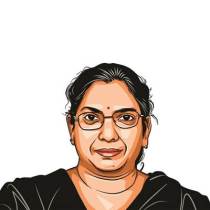Gained in Translation: Innocent criminals
The main problem of Indian jails is overcrowding. Government statistics and reports also indicate this. According to the Prison Statistics of India 2015, there are 4,19,723 prisoners in 1,401 jails. Of these, 67.2 per cent are undertrials, who languish in jails for years.
Women in jail do not get any kind of help from their families. And when she comes to prison with her children, her situation is pathetic. Such children can only learn about dogs from books, they can never see them. They are locked in after 6 pm and grow up without ever seeing the moon. (Illustration: Mithun Chakraborty)
The National Human Rights Commission (NHRC) recently wrote to all the states and Union territories asking for details of innocent children languishing in jails. It is reported that the NHRC issued the directive after hearing about 46 children living in Odisha jails without any facilities. The Commission felt that there could be more such children in jails of other states. As a political prisoner in the Hazaribagh Central Jail in Jharkhand from 2009 to 2013, I saw for myself the withering childhood of many children. There is no doubt at all that there are many more such children in jails all over India.
Women who are jailed can take their children — below five years of age — to the prison. This is to protect the rights of such children. But the rights of these children to nutritious food, recreation, education are totally neglected. Some children remain in jails, even till the age of 11 years, because jail authorities are indifferent.
During the years of my imprisonment in Hazaribagh, there were at least 25 children belonging to the approximately 100 women there. According to the rules, they have to be given milk and fruits. Milk was there but the fruits given were not edible. I wonder how jail authorities found bananas of the size of my little finger. There was a room in the ward called the ‘school’, but it had no teacher. There was ‘school’ only if political prisoners or educated convicts took up teaching.
What is surprising is that courts know fully well how innocent children suffer. District judges have the duty to ensure facilities for children in jails. When they visit the prisons, and the women’s wards, and see the children there — even if the jail authorities are successful in hiding many of the issues — the lack of facilities is clearly visible. But the judges do not take any action.
Women in jail do not get any kind of help from their families. And when she comes to prison with her children, her situation is pathetic. Such children can only learn about dogs from books, they can never see them. They are locked in after 6 pm and grow up without ever seeing the moon. They are never sent to schools outside despite Supreme Court rulings. In most jails, children don’t even have the opportunity to step outside once a week, as the rules mandate. Authorities blame lack of escorts for the children for not taking them out.
The main problem of Indian jails is overcrowding. Government statistics and reports also indicate this. According to the Prison Statistics of India 2015, there are 4,19,723 prisoners in 1,401 jails. Of these, 67.2 per cent are undertrials, who languish in jails for years. There are not enough judges to conduct speedy trials. Because cases go on for years together ‘jail is the rule, bail is the exception’ for poor undertrials and ‘bail is the rule, jail is the exception’ for the rich. It is the poor and political prisoners who spend long years in jails. Even when bail is secured, the poor do not have the capacity to provide for surety.
Many women convicts face the same problems. In December 2015, there were 17, 834 women convicts — 4.3 per cent of the total prison population. Of these, 374 were ‘convict-mothers’ with 450 children and 1,149 ‘undertrial-mothers’ with their 1,310 children. So there were 1,760 children in jail by the end of December 2015. Children over the age of five are to be re-located to government schools with hostels attached to them, but the authorities do little to ensure this. In case of children who are girls, their mothers too are afraid to send them out. Their fears are not unfounded. Jail authorities put pressure on mothers to send the children home after they cross the age of five. But to which home can a mother send her child to when there is no one to even visit them in jail?
The State is indifferent. The legal system works without any meaningful reform in colonial law. People who have cheated the country are allowed to go scot-free while those from the marginalised sections — whose ‘crimes’ are a result of inequalities in society — and progressive individuals who fight for the rights of these sections, are rotting in jail. This is the paradox of independent India.
In an unequal world, ‘crime’ is a meaningless term. Those who think that ‘criminals’ also have human rights are considered insane. The society strongly feels that once someone goes to jail, his/her life is destroyed. So women convicts/undertrials and their children are regarded as ‘The Despicable Other’.
Progressive movements have reformed the jail system in some regions, indicating how important movements are for this country. Most importantly, in north and east India, struggle for jail reforms is imperative.
B Anuradha is a women’s rights activist based in Hyderabad. Jail Kathalu is her experience of prison life. Translated from Telugu by Gita Ramaswamy
For all the latest Opinion News, download Indian Express App






































No hay comentarios:
Publicar un comentario